Screen Layouts Basics in React Native

 View on GitHub
View on GitHub
Last updated: May 2025
Building React Native apps require you to effectively organize your app's content to create a clean and useable UI. In this guide, I will walk you through the basics of screen layouts and how to implement them.
Basic Vertical Structure
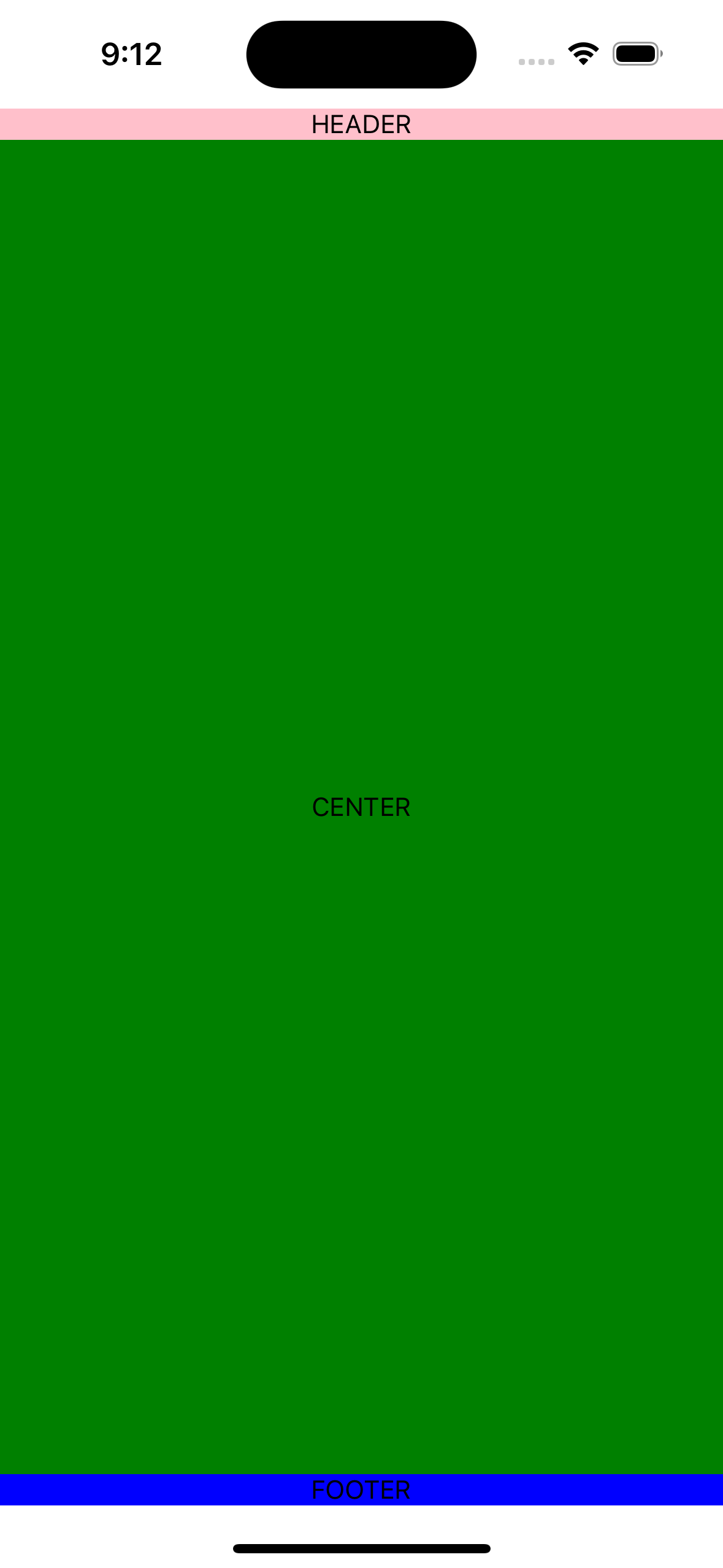
Code
import React from 'react';
import {StyleSheet, Text, View} from 'react-native';
function HomeScreen(): React.JSX.Element {
return (
<View style={{flex: 1}}>
<View style={styles.headerContainer}>
<Text>HEADER</Text>
</View>
<View style={styles.centerContainer}>
<Text>CENTER</Text>
</View>
<View style={styles.footerContainer}>
<Text>FOOTER</Text>
</View>
</View>
);
}
const styles = StyleSheet.create({
headerContainer: {
alignItems: 'center',
backgroundColor: 'pink',
},
centerContainer: {
flex: 1,
justifyContent: 'center',
alignItems: 'center',
backgroundColor: 'green',
},
footerContainer: {
alignItems: 'center',
backgroundColor: 'blue',
},
});
export default HomeScreen;
Explanation
- Wrapped everything in a
Viewand gave itflex: 1so that it takes up all of the available screen space - Created additional Views for each section on my screen: header, center, and footer
- Gave each section a different color for visualization purposes
- Gave center
flex: 1because I want to maximize its space and minimize the header and footer's space -The content in the center section is centered vertically (justifyContent: 'center') and horizontally (alignItems: 'center').
Margin vs Padding
Margins add spacing outside of the component's bounds, padding adds spacing inside of the component.
Margin
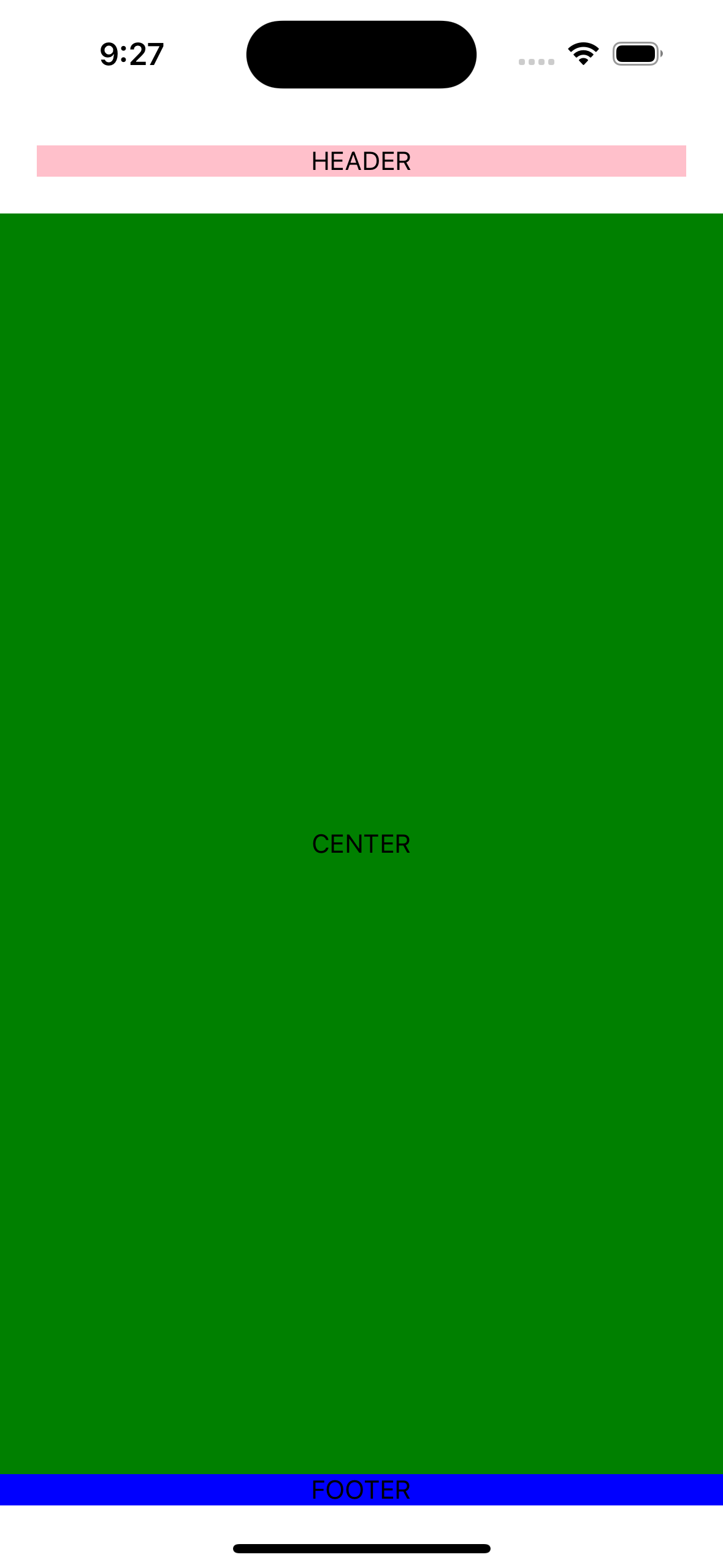
Margin Code
import React from 'react';
import {StyleSheet, Text, View} from 'react-native';
function HomeScreen(): React.JSX.Element {
return (
<View style={{flex: 1}}>
<View style={styles.headerContainer}>
<Text>HEADER</Text>
</View>
<View style={styles.centerContainer}>
<Text>CENTER</Text>
</View>
<View style={styles.footerContainer}>
<Text>FOOTER</Text>
</View>
</View>
);
}
const styles = StyleSheet.create({
headerContainer: {
alignItems: 'center',
backgroundColor: 'pink',
margin: 20, // ⭐️ This is what I added!!
},
centerContainer: {
flex: 1,
justifyContent: 'center',
alignItems: 'center',
backgroundColor: 'green',
},
footerContainer: {
alignItems: 'center',
backgroundColor: 'blue',
},
});
export default HomeScreen;
Padding
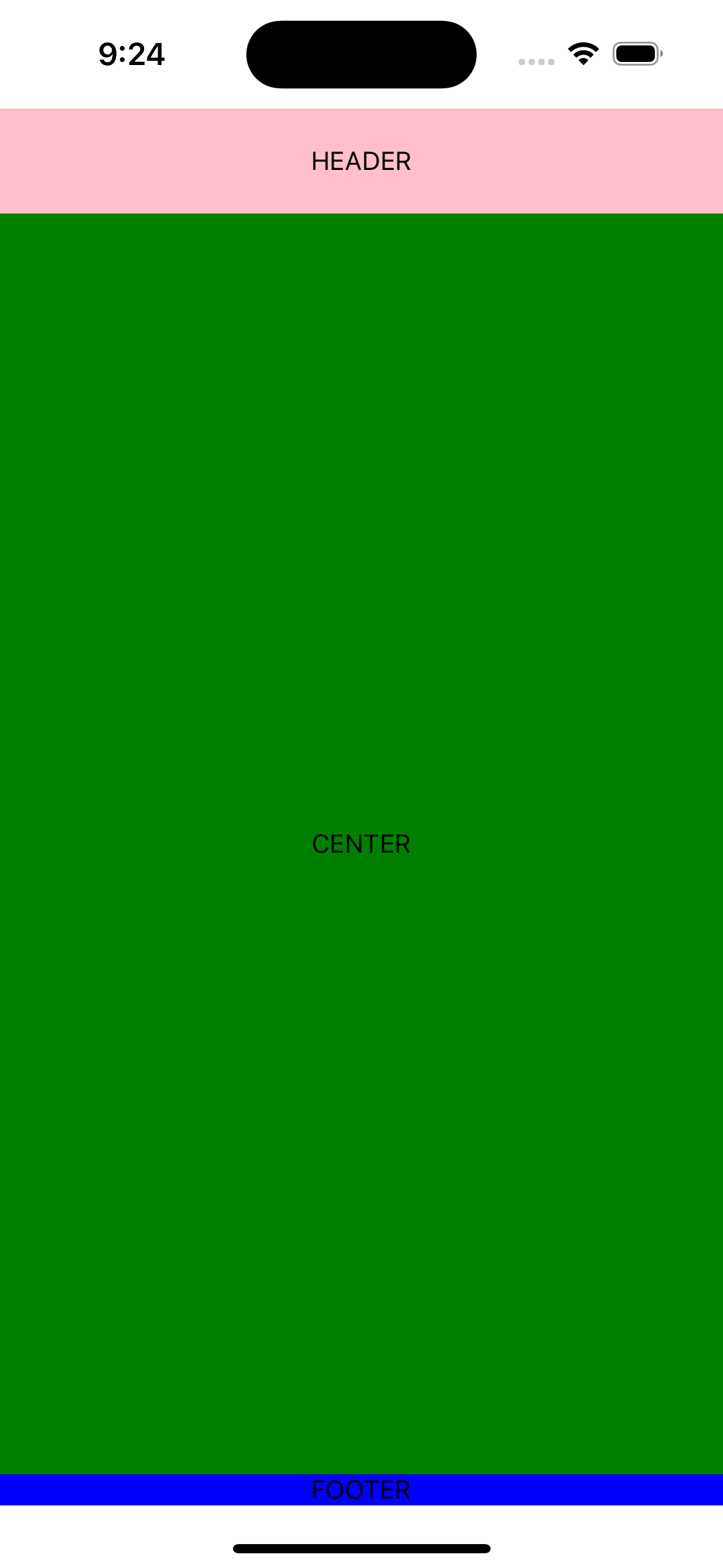
Padding Code
import React from 'react';
import {StyleSheet, Text, View} from 'react-native';
function HomeScreen(): React.JSX.Element {
return (
<View style={{flex: 1}}>
<View style={styles.headerContainer}>
<Text>HEADER</Text>
</View>
<View style={styles.centerContainer}>
<Text>CENTER</Text>
</View>
<View style={styles.footerContainer}>
<Text>FOOTER</Text>
</View>
</View>
);
}
const styles = StyleSheet.create({
headerContainer: {
alignItems: 'center',
backgroundColor: 'pink',
padding: 20, // ⭐️ I CHANGED THIS!!
},
centerContainer: {
flex: 1,
justifyContent: 'center',
alignItems: 'center',
backgroundColor: 'green',
},
footerContainer: {
alignItems: 'center',
backgroundColor: 'blue',
},
});
export default HomeScreen;
I'm going to leave the padding for the rest of the guide, fyi.
Introduction to Rows
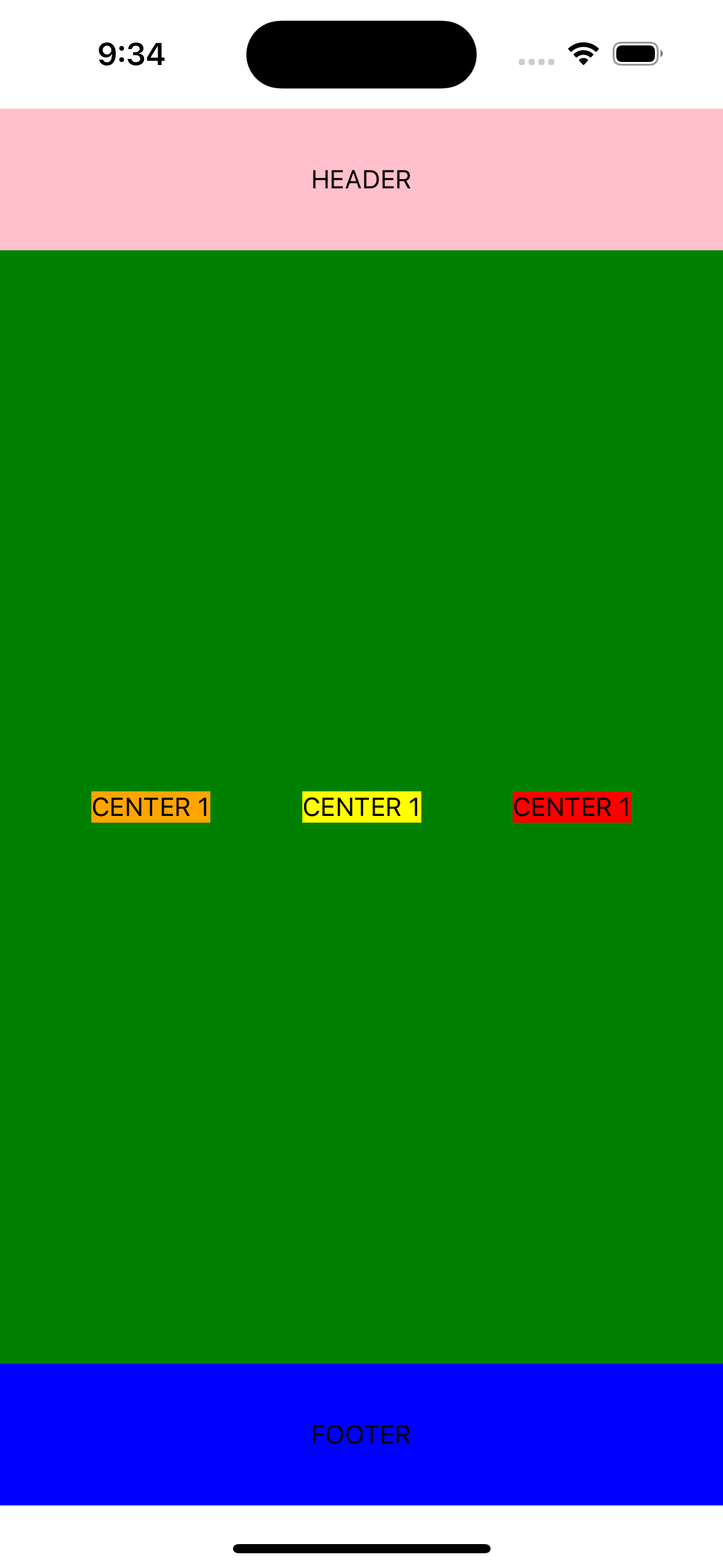
Code
import React from 'react';
import {StyleSheet, Text, View} from 'react-native';
function HomeScreen(): React.JSX.Element {
return (
<View style={{flex: 1}}>
<View style={styles.headerContainer}>
<Text>HEADER</Text>
</View>
<View style={styles.centerContainer}>
// ⭐️ ADDED THIS VIEW
<View style={styles.innerCenterContainer}>
<View style={{backgroundColor: 'orange'}}> // ⭐️ and this
<Text>CENTER 1</Text>
</View>
<View style={{backgroundColor: 'yellow'}}> // ⭐️ and this
<Text>CENTER 1</Text>
</View>
<View style={{backgroundColor: 'red'}}> // ⭐️ also this
<Text>CENTER 1</Text>
</View>
</View>
</View>
<View style={styles.footerContainer}>
<Text>FOOTER</Text>
</View>
</View>
);
}
const styles = StyleSheet.create({
headerContainer: {
alignItems: 'center',
backgroundColor: 'pink',
padding: 30,
},
centerContainer: {
flex: 1,
backgroundColor: 'green',
},
footerContainer: {
alignItems: 'center',
backgroundColor: 'blue',
padding: 30,
},
innerCenterContainer: { // ⭐️ STYLE FOR NEW VIEW
flexDirection: 'row',
justifyContent: 'space-evenly',
flex: 1,
alignItems: 'center',
},
});
export default HomeScreen;
Explanation
- Added a nested
Viewinside of the center'sView - Added
flexDirection: 'row'to the nested View - Created three additional views, one for each "box" in my row and gave each one a background color for visualization purposes
note
Now that I am writing this, I realize you could totally just use one View and combine <View style={styles.centerContainer}> and <View style={styles.innerCenterContainer}> and update centerContainer:
centerContainer: {
flex: 1,
backgroundColor: 'green',
flexDirection: 'row',
justifyContent: 'space-evenly',
flex: 1,
alignItems: 'center',
},
Multiple Rows
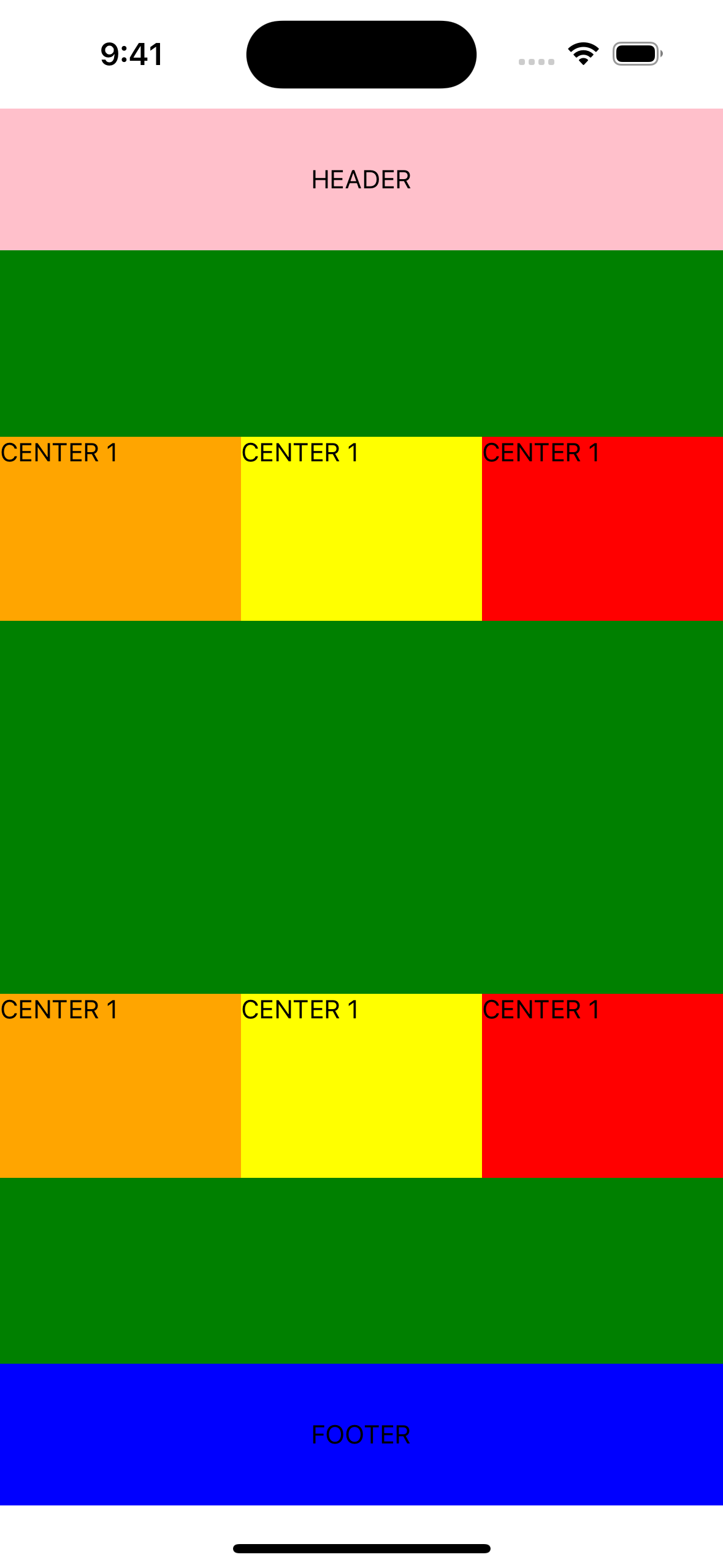
Code
import React from 'react';
import {StyleSheet, Text, View} from 'react-native';
function HomeScreen(): React.JSX.Element {
return (
<View style={{flex: 1}}>
<View style={styles.headerContainer}>
<Text>HEADER</Text>
</View>
<View style={styles.centerContainer}>
<View style={styles.innerCenterContainer}>
<View style={[styles.boxContainer, {backgroundColor: 'orange'}]}>
<Text>CENTER 1</Text>
</View>
<View style={[styles.boxContainer, {backgroundColor: 'yellow'}]}>
<Text>CENTER 1</Text>
</View>
<View style={[styles.boxContainer, {backgroundColor: 'red'}]}>
<Text>CENTER 1</Text>
</View>
</View>
<View style={styles.innerCenterContainer}>
<View style={[styles.boxContainer, {backgroundColor: 'orange'}]}>
<Text>CENTER 1</Text>
</View>
<View style={[styles.boxContainer, {backgroundColor: 'yellow'}]}>
<Text>CENTER 1</Text>
</View>
<View style={[styles.boxContainer, {backgroundColor: 'red'}]}>
<Text>CENTER 1</Text>
</View>
</View>
</View>
<View style={styles.footerContainer}>
<Text>FOOTER</Text>
</View>
</View>
);
}
const styles = StyleSheet.create({
headerContainer: {
alignItems: 'center',
backgroundColor: 'pink',
padding: 30,
},
centerContainer: {
flex: 1,
backgroundColor: 'green',
},
footerContainer: {
alignItems: 'center',
backgroundColor: 'blue',
padding: 30,
},
innerCenterContainer: {
flexDirection: 'row',
justifyContent: 'space-evenly',
flex: 1,
alignItems: 'center',
},
boxContainer: {
flex: 1,
height: 100,
}
});
export default HomeScreen;
Explanation
You can repeat and reuse the principals covered in this guide combined with css to create pretty much whatever you'd like.
- I've added an additional row here by wrapping everything in another
Viewand giving addingcenterContainerstyle